Landscape Architectural History of South Australia: An Overview
VerifiedAdded on 2020/04/29
|12
|3695
|91
Essay
AI Summary
This essay provides a comprehensive overview of the landscape architectural history of South Australia, tracing its evolution through various chronological periods, including Old Colonial, Victorian, Federation, Interwar, Postwar, and the Late Twentieth Century. It explores the influence of economic patterns, British colonization, and indigenous architectural traditions on the region's distinct characteristics. The essay highlights the impact of European architectural styles like Georgian and Gothic Revival, as well as the emergence of Victorian and Italian influences. It discusses the adaptation of architecture to Australia's climate, the role of key figures like James Bloodsworth, and the rise of Federation architecture. The essay also examines the influence of the Australian landscape, climate, and identity on the development of unique architectural features, such as the verandah, and the impact of suburban development. The study concludes by comparing South Australian architecture with other colonial and tropical architectural styles, emphasizing the unique blend of influences that have shaped the region's built environment.
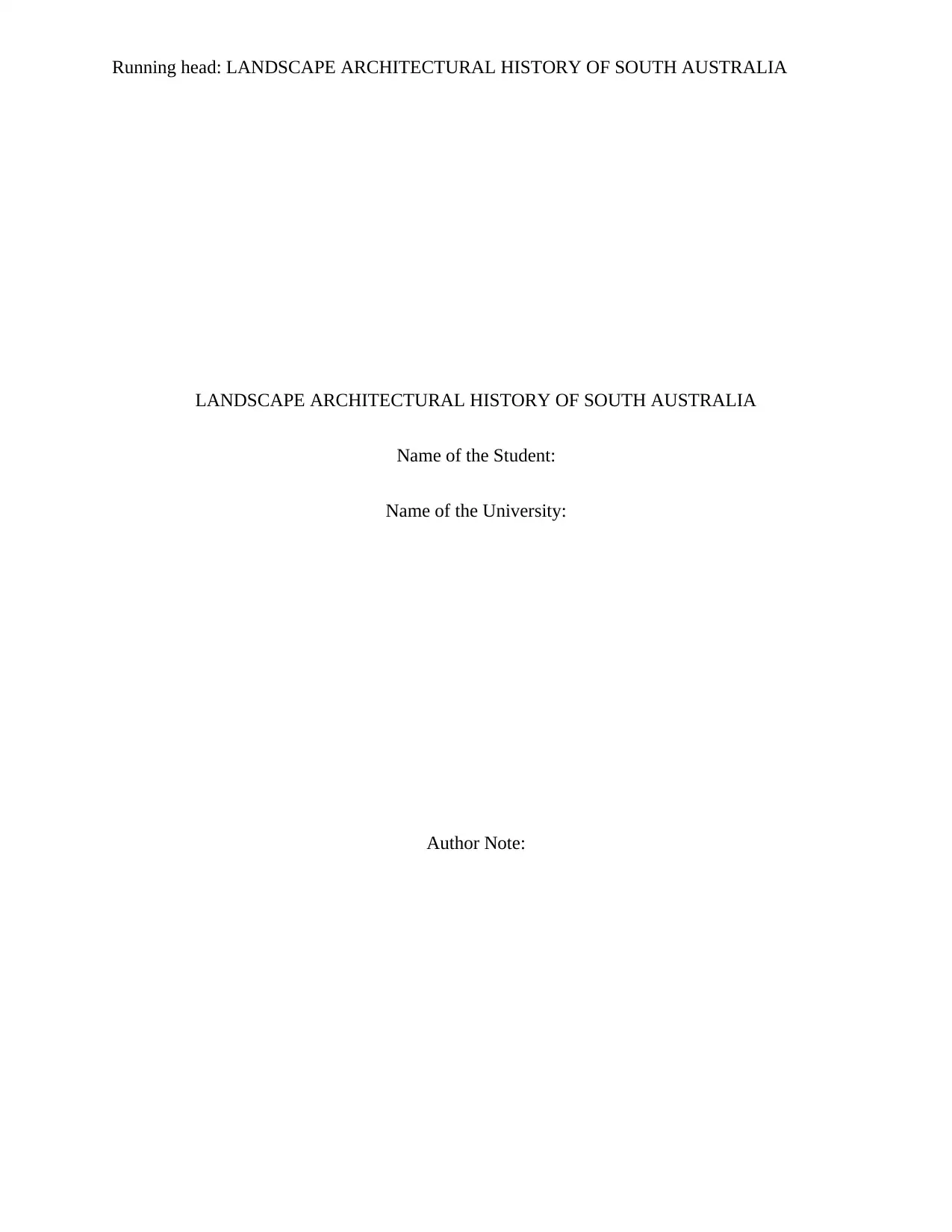
Running head: LANDSCAPE ARCHITECTURAL HISTORY OF SOUTH AUSTRALIA
LANDSCAPE ARCHITECTURAL HISTORY OF SOUTH AUSTRALIA
Name of the Student:
Name of the University:
Author Note:
LANDSCAPE ARCHITECTURAL HISTORY OF SOUTH AUSTRALIA
Name of the Student:
Name of the University:
Author Note:
Paraphrase This Document
Need a fresh take? Get an instant paraphrase of this document with our AI Paraphraser
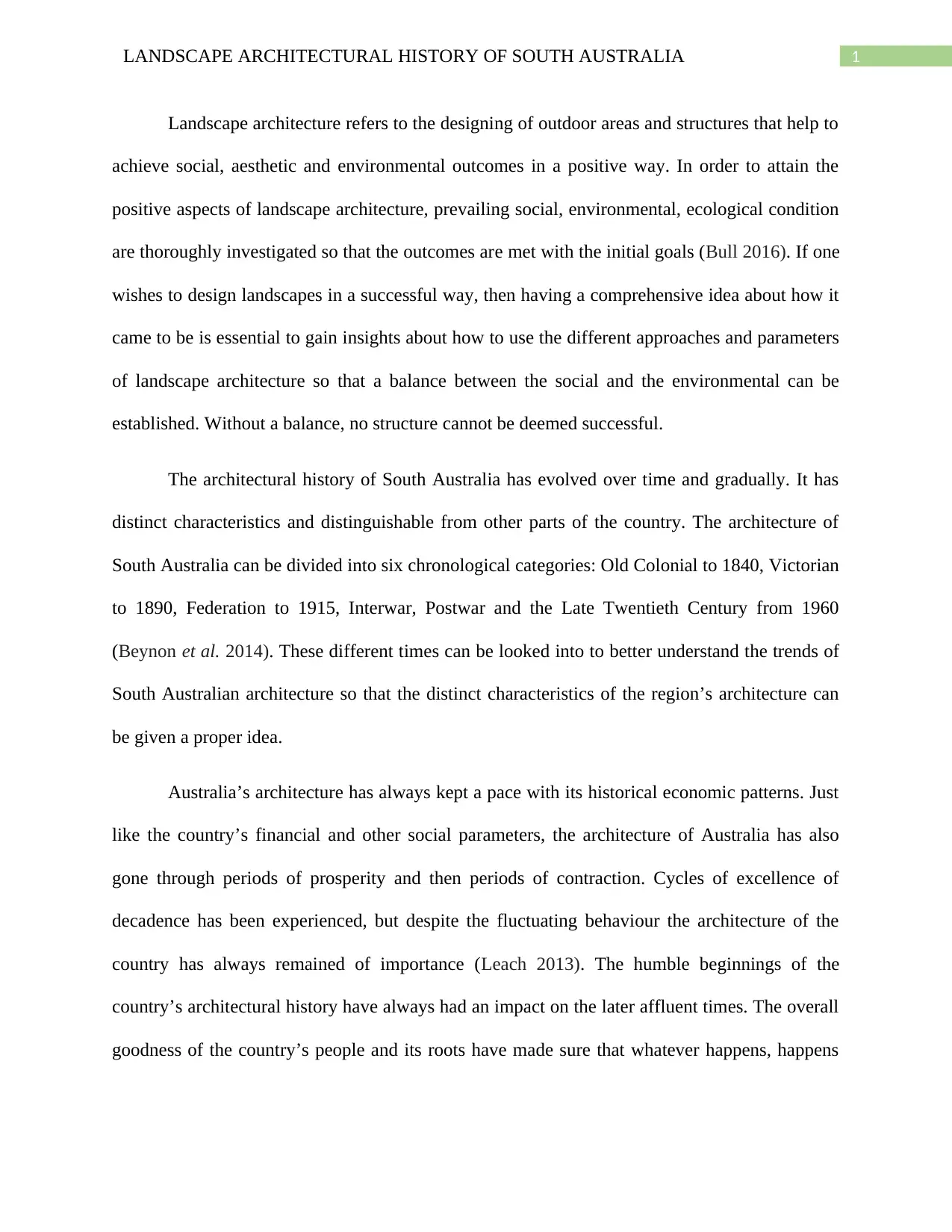
1LANDSCAPE ARCHITECTURAL HISTORY OF SOUTH AUSTRALIA
Landscape architecture refers to the designing of outdoor areas and structures that help to
achieve social, aesthetic and environmental outcomes in a positive way. In order to attain the
positive aspects of landscape architecture, prevailing social, environmental, ecological condition
are thoroughly investigated so that the outcomes are met with the initial goals (Bull 2016). If one
wishes to design landscapes in a successful way, then having a comprehensive idea about how it
came to be is essential to gain insights about how to use the different approaches and parameters
of landscape architecture so that a balance between the social and the environmental can be
established. Without a balance, no structure cannot be deemed successful.
The architectural history of South Australia has evolved over time and gradually. It has
distinct characteristics and distinguishable from other parts of the country. The architecture of
South Australia can be divided into six chronological categories: Old Colonial to 1840, Victorian
to 1890, Federation to 1915, Interwar, Postwar and the Late Twentieth Century from 1960
(Beynon et al. 2014). These different times can be looked into to better understand the trends of
South Australian architecture so that the distinct characteristics of the region’s architecture can
be given a proper idea.
Australia’s architecture has always kept a pace with its historical economic patterns. Just
like the country’s financial and other social parameters, the architecture of Australia has also
gone through periods of prosperity and then periods of contraction. Cycles of excellence of
decadence has been experienced, but despite the fluctuating behaviour the architecture of the
country has always remained of importance (Leach 2013). The humble beginnings of the
country’s architectural history have always had an impact on the later affluent times. The overall
goodness of the country’s people and its roots have made sure that whatever happens, happens
Landscape architecture refers to the designing of outdoor areas and structures that help to
achieve social, aesthetic and environmental outcomes in a positive way. In order to attain the
positive aspects of landscape architecture, prevailing social, environmental, ecological condition
are thoroughly investigated so that the outcomes are met with the initial goals (Bull 2016). If one
wishes to design landscapes in a successful way, then having a comprehensive idea about how it
came to be is essential to gain insights about how to use the different approaches and parameters
of landscape architecture so that a balance between the social and the environmental can be
established. Without a balance, no structure cannot be deemed successful.
The architectural history of South Australia has evolved over time and gradually. It has
distinct characteristics and distinguishable from other parts of the country. The architecture of
South Australia can be divided into six chronological categories: Old Colonial to 1840, Victorian
to 1890, Federation to 1915, Interwar, Postwar and the Late Twentieth Century from 1960
(Beynon et al. 2014). These different times can be looked into to better understand the trends of
South Australian architecture so that the distinct characteristics of the region’s architecture can
be given a proper idea.
Australia’s architecture has always kept a pace with its historical economic patterns. Just
like the country’s financial and other social parameters, the architecture of Australia has also
gone through periods of prosperity and then periods of contraction. Cycles of excellence of
decadence has been experienced, but despite the fluctuating behaviour the architecture of the
country has always remained of importance (Leach 2013). The humble beginnings of the
country’s architectural history have always had an impact on the later affluent times. The overall
goodness of the country’s people and its roots have made sure that whatever happens, happens
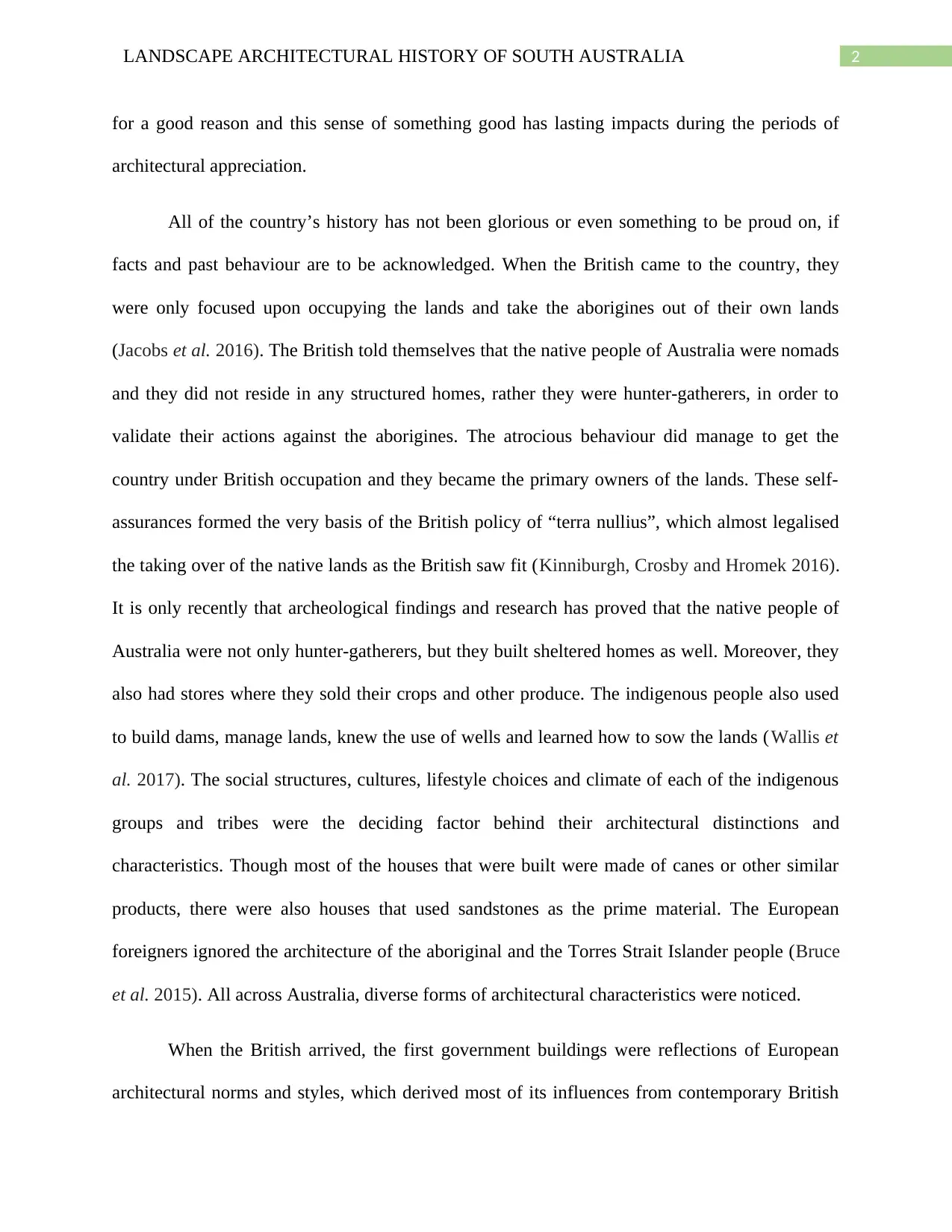
2LANDSCAPE ARCHITECTURAL HISTORY OF SOUTH AUSTRALIA
for a good reason and this sense of something good has lasting impacts during the periods of
architectural appreciation.
All of the country’s history has not been glorious or even something to be proud on, if
facts and past behaviour are to be acknowledged. When the British came to the country, they
were only focused upon occupying the lands and take the aborigines out of their own lands
(Jacobs et al. 2016). The British told themselves that the native people of Australia were nomads
and they did not reside in any structured homes, rather they were hunter-gatherers, in order to
validate their actions against the aborigines. The atrocious behaviour did manage to get the
country under British occupation and they became the primary owners of the lands. These self-
assurances formed the very basis of the British policy of “terra nullius”, which almost legalised
the taking over of the native lands as the British saw fit (Kinniburgh, Crosby and Hromek 2016).
It is only recently that archeological findings and research has proved that the native people of
Australia were not only hunter-gatherers, but they built sheltered homes as well. Moreover, they
also had stores where they sold their crops and other produce. The indigenous people also used
to build dams, manage lands, knew the use of wells and learned how to sow the lands ( Wallis et
al. 2017). The social structures, cultures, lifestyle choices and climate of each of the indigenous
groups and tribes were the deciding factor behind their architectural distinctions and
characteristics. Though most of the houses that were built were made of canes or other similar
products, there were also houses that used sandstones as the prime material. The European
foreigners ignored the architecture of the aboriginal and the Torres Strait Islander people (Bruce
et al. 2015). All across Australia, diverse forms of architectural characteristics were noticed.
When the British arrived, the first government buildings were reflections of European
architectural norms and styles, which derived most of its influences from contemporary British
for a good reason and this sense of something good has lasting impacts during the periods of
architectural appreciation.
All of the country’s history has not been glorious or even something to be proud on, if
facts and past behaviour are to be acknowledged. When the British came to the country, they
were only focused upon occupying the lands and take the aborigines out of their own lands
(Jacobs et al. 2016). The British told themselves that the native people of Australia were nomads
and they did not reside in any structured homes, rather they were hunter-gatherers, in order to
validate their actions against the aborigines. The atrocious behaviour did manage to get the
country under British occupation and they became the primary owners of the lands. These self-
assurances formed the very basis of the British policy of “terra nullius”, which almost legalised
the taking over of the native lands as the British saw fit (Kinniburgh, Crosby and Hromek 2016).
It is only recently that archeological findings and research has proved that the native people of
Australia were not only hunter-gatherers, but they built sheltered homes as well. Moreover, they
also had stores where they sold their crops and other produce. The indigenous people also used
to build dams, manage lands, knew the use of wells and learned how to sow the lands ( Wallis et
al. 2017). The social structures, cultures, lifestyle choices and climate of each of the indigenous
groups and tribes were the deciding factor behind their architectural distinctions and
characteristics. Though most of the houses that were built were made of canes or other similar
products, there were also houses that used sandstones as the prime material. The European
foreigners ignored the architecture of the aboriginal and the Torres Strait Islander people (Bruce
et al. 2015). All across Australia, diverse forms of architectural characteristics were noticed.
When the British arrived, the first government buildings were reflections of European
architectural norms and styles, which derived most of its influences from contemporary British
⊘ This is a preview!⊘
Do you want full access?
Subscribe today to unlock all pages.

Trusted by 1+ million students worldwide
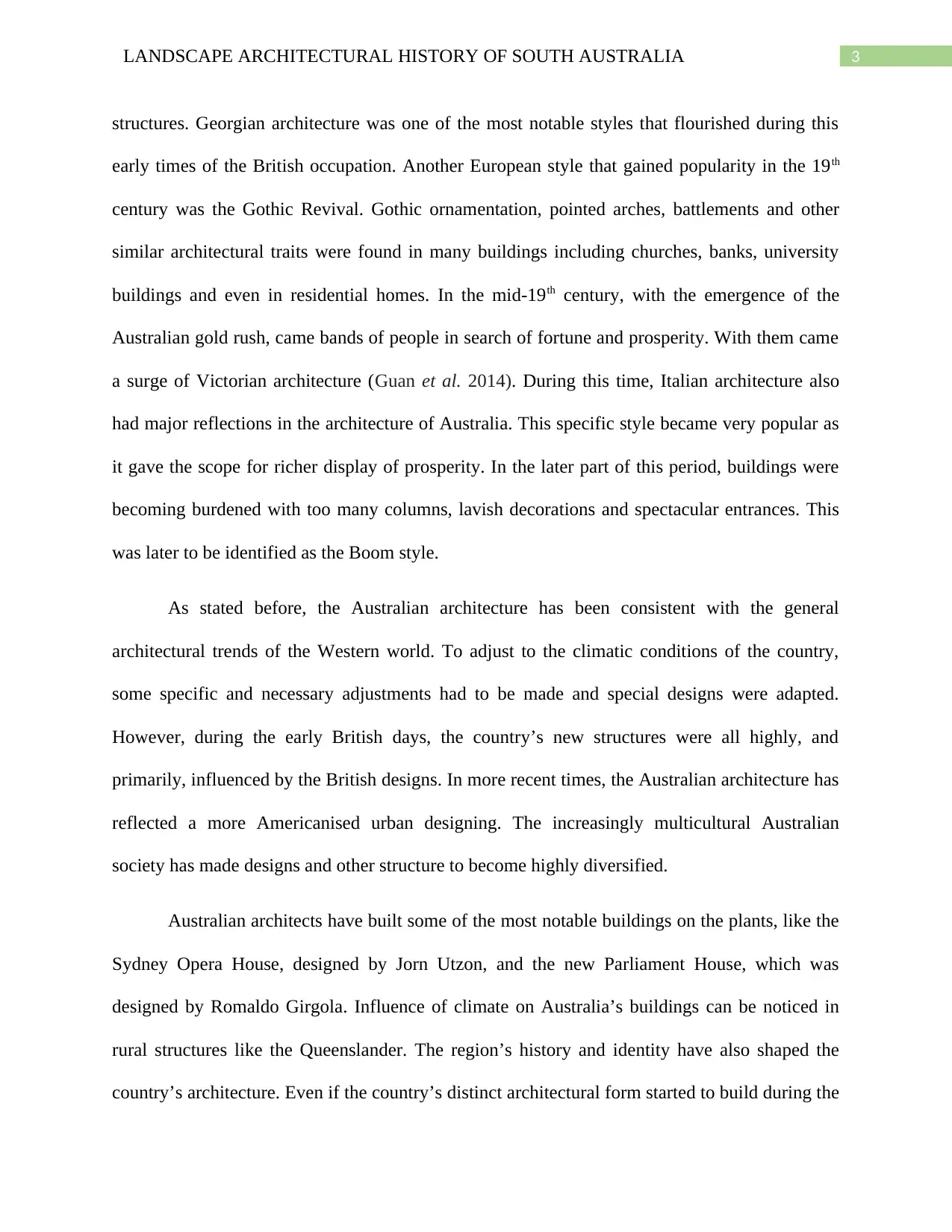
3LANDSCAPE ARCHITECTURAL HISTORY OF SOUTH AUSTRALIA
structures. Georgian architecture was one of the most notable styles that flourished during this
early times of the British occupation. Another European style that gained popularity in the 19th
century was the Gothic Revival. Gothic ornamentation, pointed arches, battlements and other
similar architectural traits were found in many buildings including churches, banks, university
buildings and even in residential homes. In the mid-19th century, with the emergence of the
Australian gold rush, came bands of people in search of fortune and prosperity. With them came
a surge of Victorian architecture (Guan et al. 2014). During this time, Italian architecture also
had major reflections in the architecture of Australia. This specific style became very popular as
it gave the scope for richer display of prosperity. In the later part of this period, buildings were
becoming burdened with too many columns, lavish decorations and spectacular entrances. This
was later to be identified as the Boom style.
As stated before, the Australian architecture has been consistent with the general
architectural trends of the Western world. To adjust to the climatic conditions of the country,
some specific and necessary adjustments had to be made and special designs were adapted.
However, during the early British days, the country’s new structures were all highly, and
primarily, influenced by the British designs. In more recent times, the Australian architecture has
reflected a more Americanised urban designing. The increasingly multicultural Australian
society has made designs and other structure to become highly diversified.
Australian architects have built some of the most notable buildings on the plants, like the
Sydney Opera House, designed by Jorn Utzon, and the new Parliament House, which was
designed by Romaldo Girgola. Influence of climate on Australia’s buildings can be noticed in
rural structures like the Queenslander. The region’s history and identity have also shaped the
country’s architecture. Even if the country’s distinct architectural form started to build during the
structures. Georgian architecture was one of the most notable styles that flourished during this
early times of the British occupation. Another European style that gained popularity in the 19th
century was the Gothic Revival. Gothic ornamentation, pointed arches, battlements and other
similar architectural traits were found in many buildings including churches, banks, university
buildings and even in residential homes. In the mid-19th century, with the emergence of the
Australian gold rush, came bands of people in search of fortune and prosperity. With them came
a surge of Victorian architecture (Guan et al. 2014). During this time, Italian architecture also
had major reflections in the architecture of Australia. This specific style became very popular as
it gave the scope for richer display of prosperity. In the later part of this period, buildings were
becoming burdened with too many columns, lavish decorations and spectacular entrances. This
was later to be identified as the Boom style.
As stated before, the Australian architecture has been consistent with the general
architectural trends of the Western world. To adjust to the climatic conditions of the country,
some specific and necessary adjustments had to be made and special designs were adapted.
However, during the early British days, the country’s new structures were all highly, and
primarily, influenced by the British designs. In more recent times, the Australian architecture has
reflected a more Americanised urban designing. The increasingly multicultural Australian
society has made designs and other structure to become highly diversified.
Australian architects have built some of the most notable buildings on the plants, like the
Sydney Opera House, designed by Jorn Utzon, and the new Parliament House, which was
designed by Romaldo Girgola. Influence of climate on Australia’s buildings can be noticed in
rural structures like the Queenslander. The region’s history and identity have also shaped the
country’s architecture. Even if the country’s distinct architectural form started to build during the
Paraphrase This Document
Need a fresh take? Get an instant paraphrase of this document with our AI Paraphraser
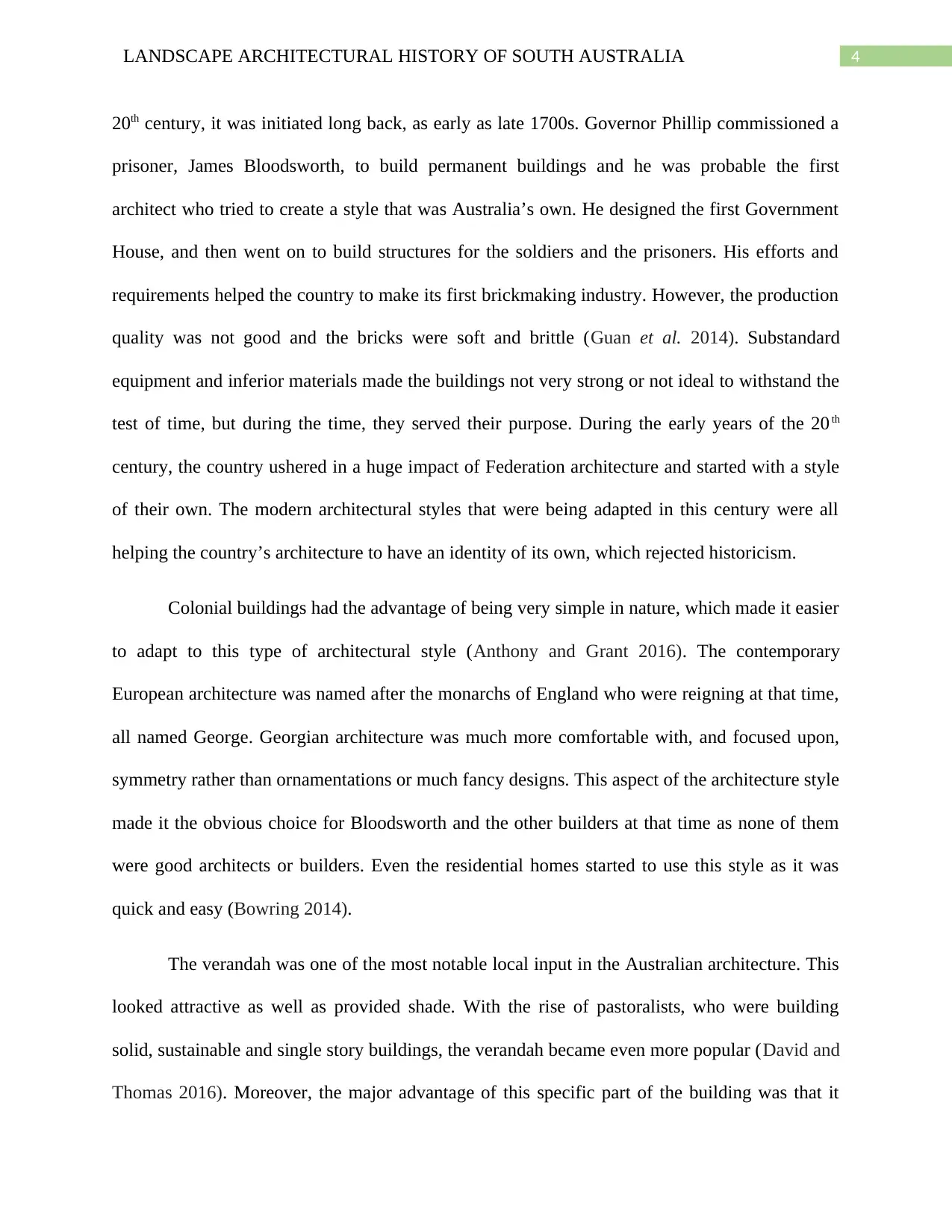
4LANDSCAPE ARCHITECTURAL HISTORY OF SOUTH AUSTRALIA
20th century, it was initiated long back, as early as late 1700s. Governor Phillip commissioned a
prisoner, James Bloodsworth, to build permanent buildings and he was probable the first
architect who tried to create a style that was Australia’s own. He designed the first Government
House, and then went on to build structures for the soldiers and the prisoners. His efforts and
requirements helped the country to make its first brickmaking industry. However, the production
quality was not good and the bricks were soft and brittle (Guan et al. 2014). Substandard
equipment and inferior materials made the buildings not very strong or not ideal to withstand the
test of time, but during the time, they served their purpose. During the early years of the 20 th
century, the country ushered in a huge impact of Federation architecture and started with a style
of their own. The modern architectural styles that were being adapted in this century were all
helping the country’s architecture to have an identity of its own, which rejected historicism.
Colonial buildings had the advantage of being very simple in nature, which made it easier
to adapt to this type of architectural style (Anthony and Grant 2016). The contemporary
European architecture was named after the monarchs of England who were reigning at that time,
all named George. Georgian architecture was much more comfortable with, and focused upon,
symmetry rather than ornamentations or much fancy designs. This aspect of the architecture style
made it the obvious choice for Bloodsworth and the other builders at that time as none of them
were good architects or builders. Even the residential homes started to use this style as it was
quick and easy (Bowring 2014).
The verandah was one of the most notable local input in the Australian architecture. This
looked attractive as well as provided shade. With the rise of pastoralists, who were building
solid, sustainable and single story buildings, the verandah became even more popular (David and
Thomas 2016). Moreover, the major advantage of this specific part of the building was that it
20th century, it was initiated long back, as early as late 1700s. Governor Phillip commissioned a
prisoner, James Bloodsworth, to build permanent buildings and he was probable the first
architect who tried to create a style that was Australia’s own. He designed the first Government
House, and then went on to build structures for the soldiers and the prisoners. His efforts and
requirements helped the country to make its first brickmaking industry. However, the production
quality was not good and the bricks were soft and brittle (Guan et al. 2014). Substandard
equipment and inferior materials made the buildings not very strong or not ideal to withstand the
test of time, but during the time, they served their purpose. During the early years of the 20 th
century, the country ushered in a huge impact of Federation architecture and started with a style
of their own. The modern architectural styles that were being adapted in this century were all
helping the country’s architecture to have an identity of its own, which rejected historicism.
Colonial buildings had the advantage of being very simple in nature, which made it easier
to adapt to this type of architectural style (Anthony and Grant 2016). The contemporary
European architecture was named after the monarchs of England who were reigning at that time,
all named George. Georgian architecture was much more comfortable with, and focused upon,
symmetry rather than ornamentations or much fancy designs. This aspect of the architecture style
made it the obvious choice for Bloodsworth and the other builders at that time as none of them
were good architects or builders. Even the residential homes started to use this style as it was
quick and easy (Bowring 2014).
The verandah was one of the most notable local input in the Australian architecture. This
looked attractive as well as provided shade. With the rise of pastoralists, who were building
solid, sustainable and single story buildings, the verandah became even more popular (David and
Thomas 2016). Moreover, the major advantage of this specific part of the building was that it
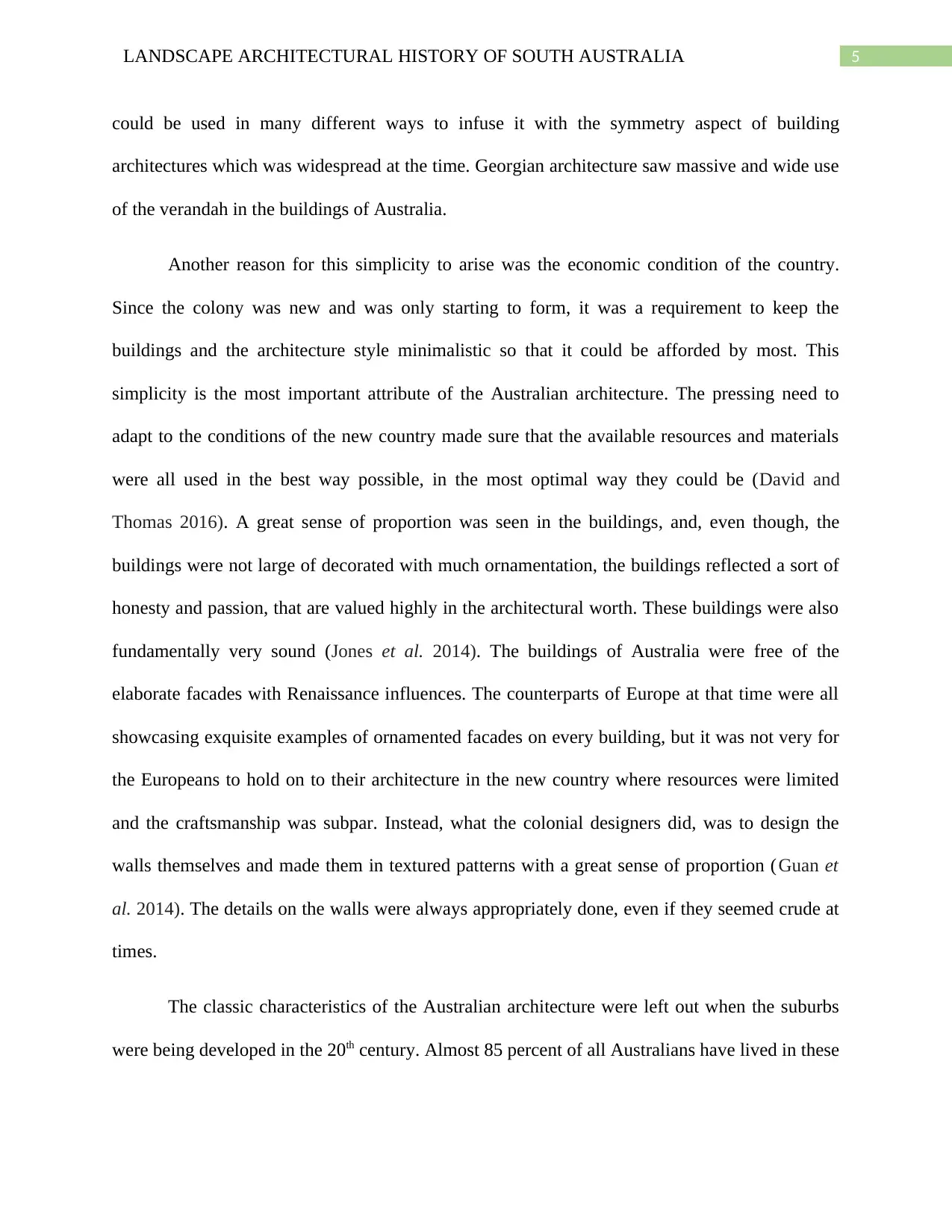
5LANDSCAPE ARCHITECTURAL HISTORY OF SOUTH AUSTRALIA
could be used in many different ways to infuse it with the symmetry aspect of building
architectures which was widespread at the time. Georgian architecture saw massive and wide use
of the verandah in the buildings of Australia.
Another reason for this simplicity to arise was the economic condition of the country.
Since the colony was new and was only starting to form, it was a requirement to keep the
buildings and the architecture style minimalistic so that it could be afforded by most. This
simplicity is the most important attribute of the Australian architecture. The pressing need to
adapt to the conditions of the new country made sure that the available resources and materials
were all used in the best way possible, in the most optimal way they could be (David and
Thomas 2016). A great sense of proportion was seen in the buildings, and, even though, the
buildings were not large of decorated with much ornamentation, the buildings reflected a sort of
honesty and passion, that are valued highly in the architectural worth. These buildings were also
fundamentally very sound (Jones et al. 2014). The buildings of Australia were free of the
elaborate facades with Renaissance influences. The counterparts of Europe at that time were all
showcasing exquisite examples of ornamented facades on every building, but it was not very for
the Europeans to hold on to their architecture in the new country where resources were limited
and the craftsmanship was subpar. Instead, what the colonial designers did, was to design the
walls themselves and made them in textured patterns with a great sense of proportion ( Guan et
al. 2014). The details on the walls were always appropriately done, even if they seemed crude at
times.
The classic characteristics of the Australian architecture were left out when the suburbs
were being developed in the 20th century. Almost 85 percent of all Australians have lived in these
could be used in many different ways to infuse it with the symmetry aspect of building
architectures which was widespread at the time. Georgian architecture saw massive and wide use
of the verandah in the buildings of Australia.
Another reason for this simplicity to arise was the economic condition of the country.
Since the colony was new and was only starting to form, it was a requirement to keep the
buildings and the architecture style minimalistic so that it could be afforded by most. This
simplicity is the most important attribute of the Australian architecture. The pressing need to
adapt to the conditions of the new country made sure that the available resources and materials
were all used in the best way possible, in the most optimal way they could be (David and
Thomas 2016). A great sense of proportion was seen in the buildings, and, even though, the
buildings were not large of decorated with much ornamentation, the buildings reflected a sort of
honesty and passion, that are valued highly in the architectural worth. These buildings were also
fundamentally very sound (Jones et al. 2014). The buildings of Australia were free of the
elaborate facades with Renaissance influences. The counterparts of Europe at that time were all
showcasing exquisite examples of ornamented facades on every building, but it was not very for
the Europeans to hold on to their architecture in the new country where resources were limited
and the craftsmanship was subpar. Instead, what the colonial designers did, was to design the
walls themselves and made them in textured patterns with a great sense of proportion ( Guan et
al. 2014). The details on the walls were always appropriately done, even if they seemed crude at
times.
The classic characteristics of the Australian architecture were left out when the suburbs
were being developed in the 20th century. Almost 85 percent of all Australians have lived in these
⊘ This is a preview!⊘
Do you want full access?
Subscribe today to unlock all pages.

Trusted by 1+ million students worldwide
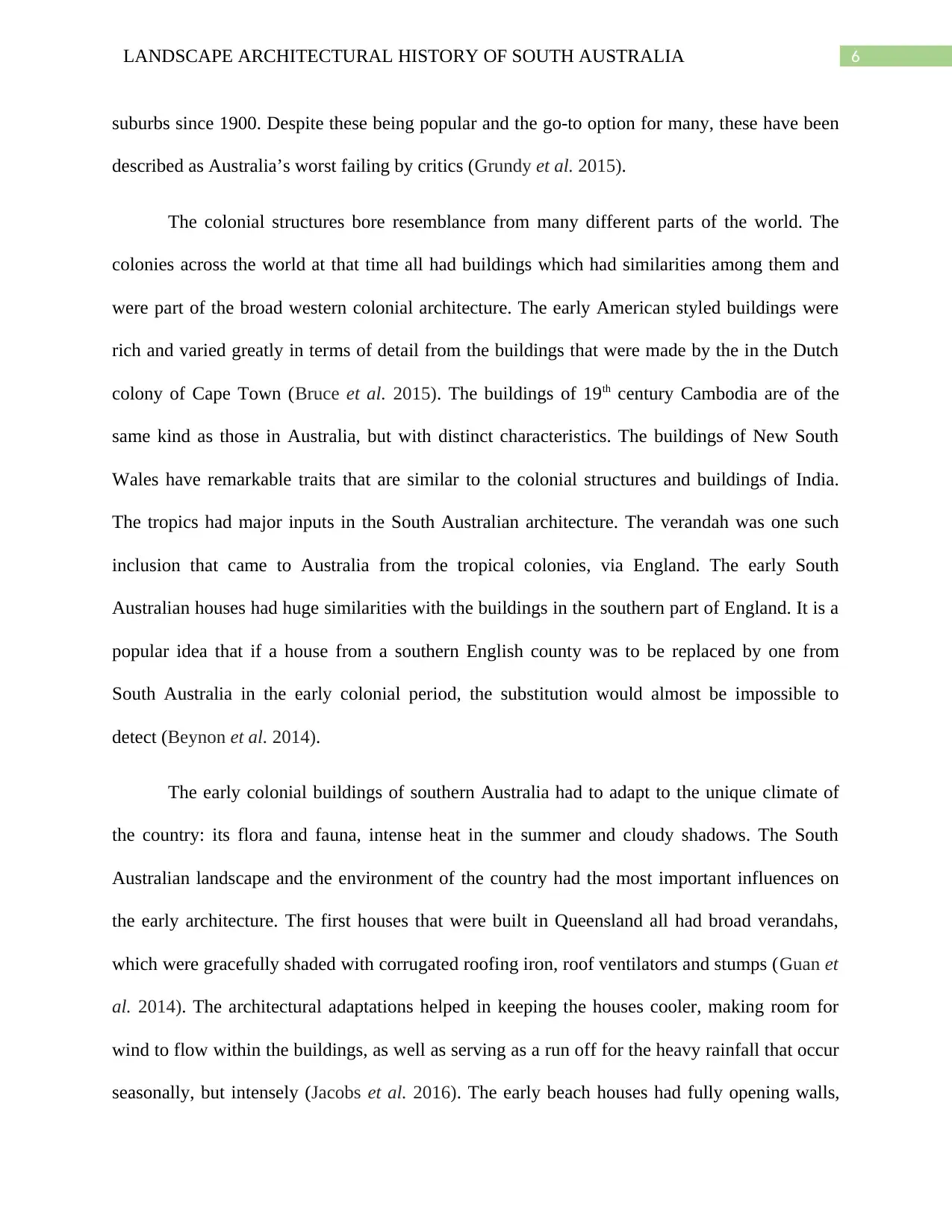
6LANDSCAPE ARCHITECTURAL HISTORY OF SOUTH AUSTRALIA
suburbs since 1900. Despite these being popular and the go-to option for many, these have been
described as Australia’s worst failing by critics (Grundy et al. 2015).
The colonial structures bore resemblance from many different parts of the world. The
colonies across the world at that time all had buildings which had similarities among them and
were part of the broad western colonial architecture. The early American styled buildings were
rich and varied greatly in terms of detail from the buildings that were made by the in the Dutch
colony of Cape Town (Bruce et al. 2015). The buildings of 19th century Cambodia are of the
same kind as those in Australia, but with distinct characteristics. The buildings of New South
Wales have remarkable traits that are similar to the colonial structures and buildings of India.
The tropics had major inputs in the South Australian architecture. The verandah was one such
inclusion that came to Australia from the tropical colonies, via England. The early South
Australian houses had huge similarities with the buildings in the southern part of England. It is a
popular idea that if a house from a southern English county was to be replaced by one from
South Australia in the early colonial period, the substitution would almost be impossible to
detect (Beynon et al. 2014).
The early colonial buildings of southern Australia had to adapt to the unique climate of
the country: its flora and fauna, intense heat in the summer and cloudy shadows. The South
Australian landscape and the environment of the country had the most important influences on
the early architecture. The first houses that were built in Queensland all had broad verandahs,
which were gracefully shaded with corrugated roofing iron, roof ventilators and stumps (Guan et
al. 2014). The architectural adaptations helped in keeping the houses cooler, making room for
wind to flow within the buildings, as well as serving as a run off for the heavy rainfall that occur
seasonally, but intensely (Jacobs et al. 2016). The early beach houses had fully opening walls,
suburbs since 1900. Despite these being popular and the go-to option for many, these have been
described as Australia’s worst failing by critics (Grundy et al. 2015).
The colonial structures bore resemblance from many different parts of the world. The
colonies across the world at that time all had buildings which had similarities among them and
were part of the broad western colonial architecture. The early American styled buildings were
rich and varied greatly in terms of detail from the buildings that were made by the in the Dutch
colony of Cape Town (Bruce et al. 2015). The buildings of 19th century Cambodia are of the
same kind as those in Australia, but with distinct characteristics. The buildings of New South
Wales have remarkable traits that are similar to the colonial structures and buildings of India.
The tropics had major inputs in the South Australian architecture. The verandah was one such
inclusion that came to Australia from the tropical colonies, via England. The early South
Australian houses had huge similarities with the buildings in the southern part of England. It is a
popular idea that if a house from a southern English county was to be replaced by one from
South Australia in the early colonial period, the substitution would almost be impossible to
detect (Beynon et al. 2014).
The early colonial buildings of southern Australia had to adapt to the unique climate of
the country: its flora and fauna, intense heat in the summer and cloudy shadows. The South
Australian landscape and the environment of the country had the most important influences on
the early architecture. The first houses that were built in Queensland all had broad verandahs,
which were gracefully shaded with corrugated roofing iron, roof ventilators and stumps (Guan et
al. 2014). The architectural adaptations helped in keeping the houses cooler, making room for
wind to flow within the buildings, as well as serving as a run off for the heavy rainfall that occur
seasonally, but intensely (Jacobs et al. 2016). The early beach houses had fully opening walls,
Paraphrase This Document
Need a fresh take? Get an instant paraphrase of this document with our AI Paraphraser
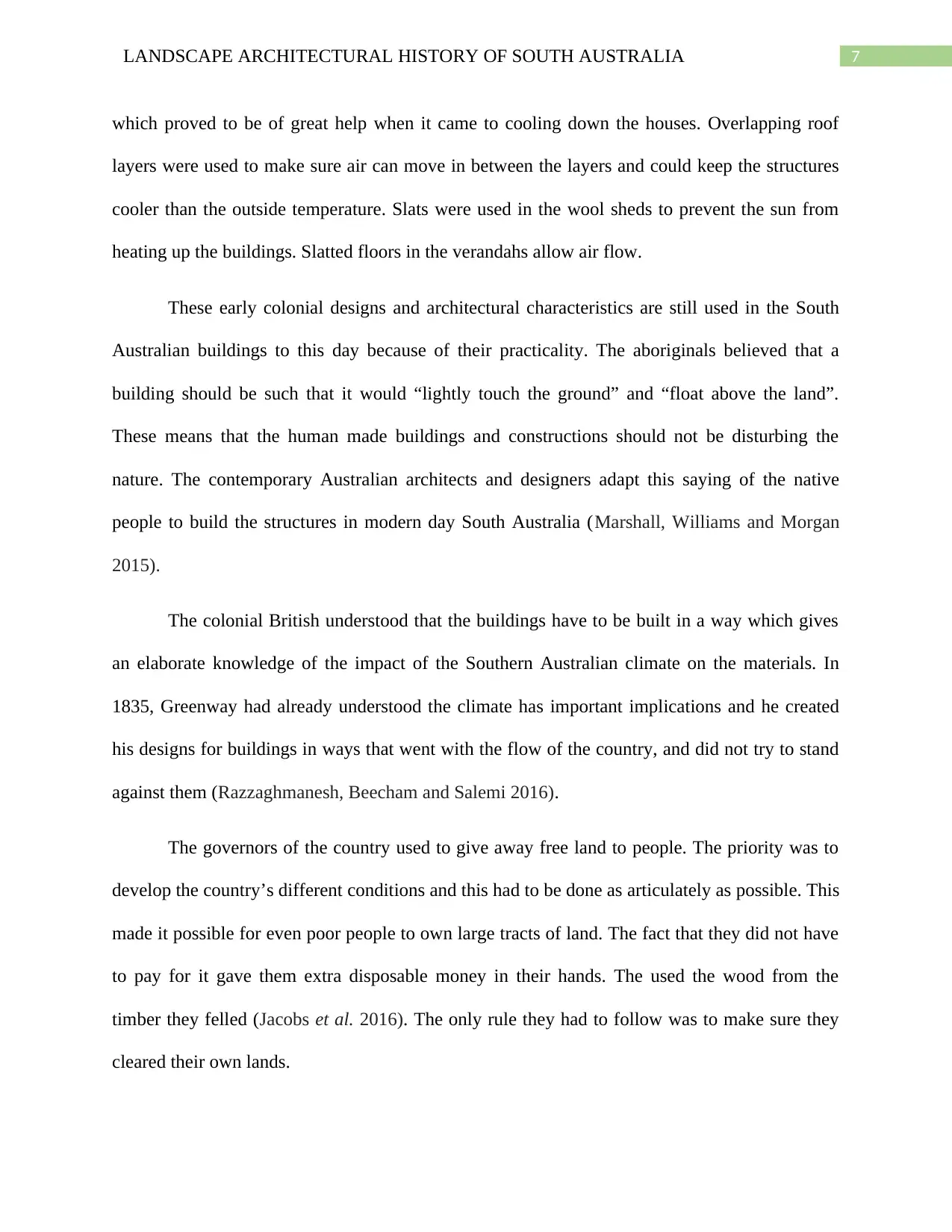
7LANDSCAPE ARCHITECTURAL HISTORY OF SOUTH AUSTRALIA
which proved to be of great help when it came to cooling down the houses. Overlapping roof
layers were used to make sure air can move in between the layers and could keep the structures
cooler than the outside temperature. Slats were used in the wool sheds to prevent the sun from
heating up the buildings. Slatted floors in the verandahs allow air flow.
These early colonial designs and architectural characteristics are still used in the South
Australian buildings to this day because of their practicality. The aboriginals believed that a
building should be such that it would “lightly touch the ground” and “float above the land”.
These means that the human made buildings and constructions should not be disturbing the
nature. The contemporary Australian architects and designers adapt this saying of the native
people to build the structures in modern day South Australia (Marshall, Williams and Morgan
2015).
The colonial British understood that the buildings have to be built in a way which gives
an elaborate knowledge of the impact of the Southern Australian climate on the materials. In
1835, Greenway had already understood the climate has important implications and he created
his designs for buildings in ways that went with the flow of the country, and did not try to stand
against them (Razzaghmanesh, Beecham and Salemi 2016).
The governors of the country used to give away free land to people. The priority was to
develop the country’s different conditions and this had to be done as articulately as possible. This
made it possible for even poor people to own large tracts of land. The fact that they did not have
to pay for it gave them extra disposable money in their hands. The used the wood from the
timber they felled (Jacobs et al. 2016). The only rule they had to follow was to make sure they
cleared their own lands.
which proved to be of great help when it came to cooling down the houses. Overlapping roof
layers were used to make sure air can move in between the layers and could keep the structures
cooler than the outside temperature. Slats were used in the wool sheds to prevent the sun from
heating up the buildings. Slatted floors in the verandahs allow air flow.
These early colonial designs and architectural characteristics are still used in the South
Australian buildings to this day because of their practicality. The aboriginals believed that a
building should be such that it would “lightly touch the ground” and “float above the land”.
These means that the human made buildings and constructions should not be disturbing the
nature. The contemporary Australian architects and designers adapt this saying of the native
people to build the structures in modern day South Australia (Marshall, Williams and Morgan
2015).
The colonial British understood that the buildings have to be built in a way which gives
an elaborate knowledge of the impact of the Southern Australian climate on the materials. In
1835, Greenway had already understood the climate has important implications and he created
his designs for buildings in ways that went with the flow of the country, and did not try to stand
against them (Razzaghmanesh, Beecham and Salemi 2016).
The governors of the country used to give away free land to people. The priority was to
develop the country’s different conditions and this had to be done as articulately as possible. This
made it possible for even poor people to own large tracts of land. The fact that they did not have
to pay for it gave them extra disposable money in their hands. The used the wood from the
timber they felled (Jacobs et al. 2016). The only rule they had to follow was to make sure they
cleared their own lands.
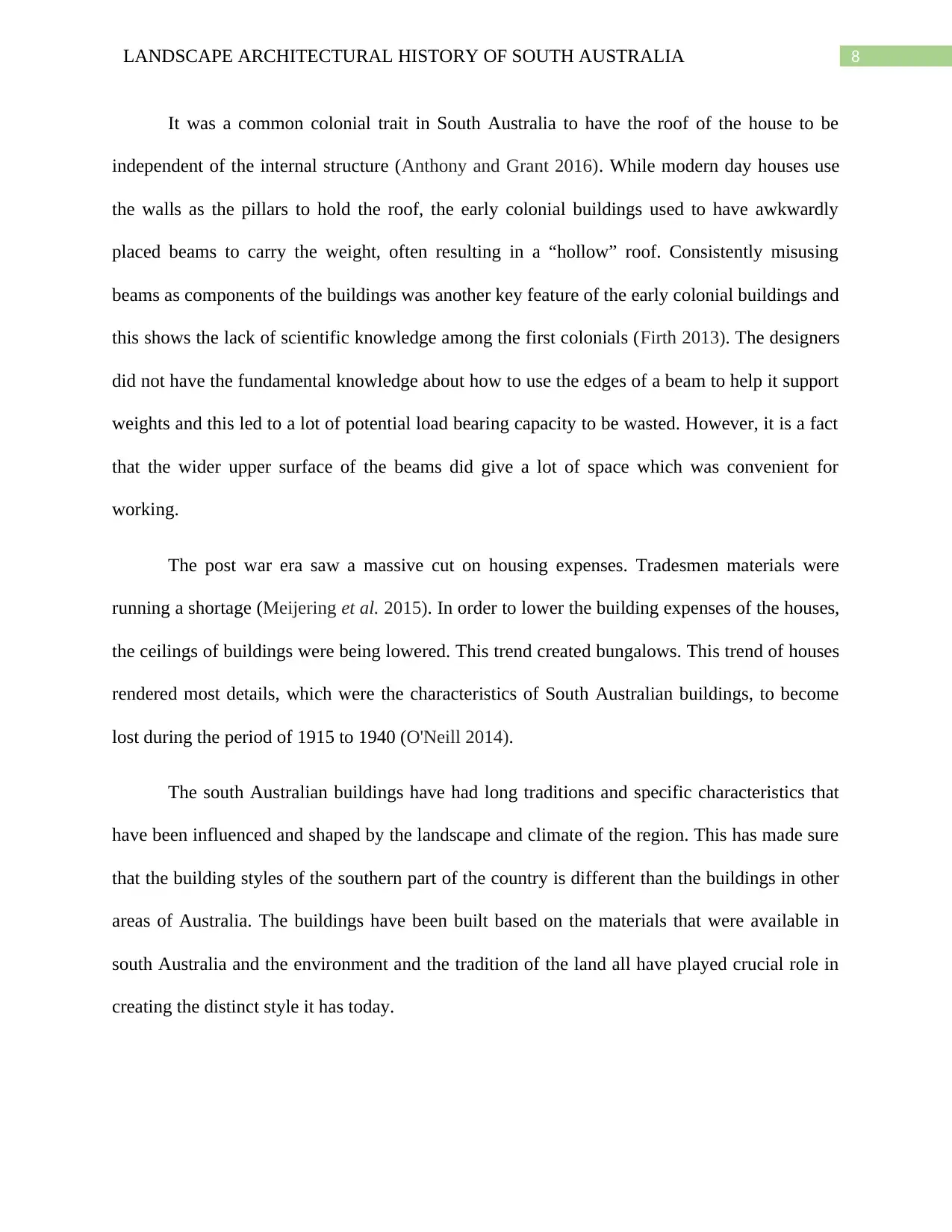
8LANDSCAPE ARCHITECTURAL HISTORY OF SOUTH AUSTRALIA
It was a common colonial trait in South Australia to have the roof of the house to be
independent of the internal structure (Anthony and Grant 2016). While modern day houses use
the walls as the pillars to hold the roof, the early colonial buildings used to have awkwardly
placed beams to carry the weight, often resulting in a “hollow” roof. Consistently misusing
beams as components of the buildings was another key feature of the early colonial buildings and
this shows the lack of scientific knowledge among the first colonials (Firth 2013). The designers
did not have the fundamental knowledge about how to use the edges of a beam to help it support
weights and this led to a lot of potential load bearing capacity to be wasted. However, it is a fact
that the wider upper surface of the beams did give a lot of space which was convenient for
working.
The post war era saw a massive cut on housing expenses. Tradesmen materials were
running a shortage (Meijering et al. 2015). In order to lower the building expenses of the houses,
the ceilings of buildings were being lowered. This trend created bungalows. This trend of houses
rendered most details, which were the characteristics of South Australian buildings, to become
lost during the period of 1915 to 1940 (O'Neill 2014).
The south Australian buildings have had long traditions and specific characteristics that
have been influenced and shaped by the landscape and climate of the region. This has made sure
that the building styles of the southern part of the country is different than the buildings in other
areas of Australia. The buildings have been built based on the materials that were available in
south Australia and the environment and the tradition of the land all have played crucial role in
creating the distinct style it has today.
It was a common colonial trait in South Australia to have the roof of the house to be
independent of the internal structure (Anthony and Grant 2016). While modern day houses use
the walls as the pillars to hold the roof, the early colonial buildings used to have awkwardly
placed beams to carry the weight, often resulting in a “hollow” roof. Consistently misusing
beams as components of the buildings was another key feature of the early colonial buildings and
this shows the lack of scientific knowledge among the first colonials (Firth 2013). The designers
did not have the fundamental knowledge about how to use the edges of a beam to help it support
weights and this led to a lot of potential load bearing capacity to be wasted. However, it is a fact
that the wider upper surface of the beams did give a lot of space which was convenient for
working.
The post war era saw a massive cut on housing expenses. Tradesmen materials were
running a shortage (Meijering et al. 2015). In order to lower the building expenses of the houses,
the ceilings of buildings were being lowered. This trend created bungalows. This trend of houses
rendered most details, which were the characteristics of South Australian buildings, to become
lost during the period of 1915 to 1940 (O'Neill 2014).
The south Australian buildings have had long traditions and specific characteristics that
have been influenced and shaped by the landscape and climate of the region. This has made sure
that the building styles of the southern part of the country is different than the buildings in other
areas of Australia. The buildings have been built based on the materials that were available in
south Australia and the environment and the tradition of the land all have played crucial role in
creating the distinct style it has today.
⊘ This is a preview!⊘
Do you want full access?
Subscribe today to unlock all pages.

Trusted by 1+ million students worldwide
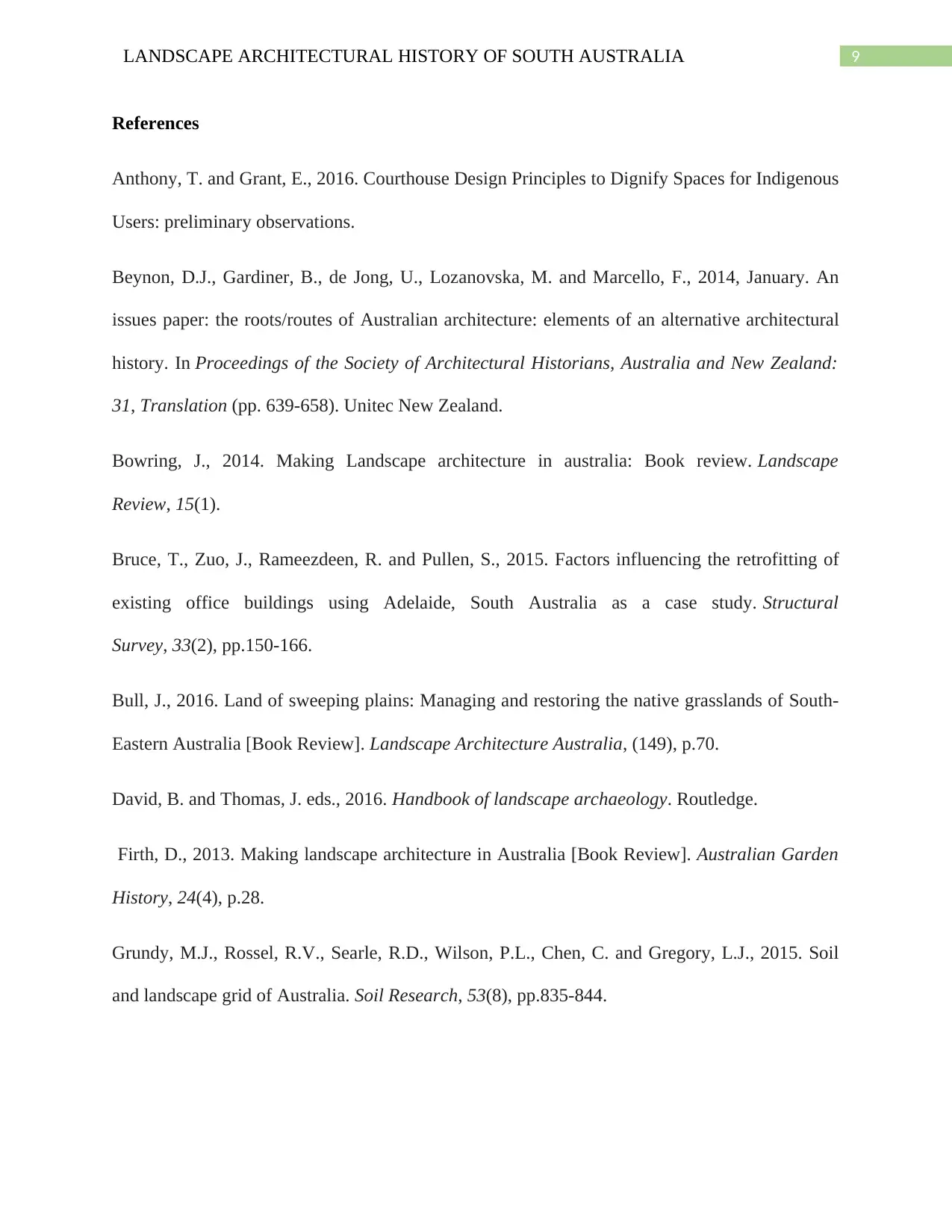
9LANDSCAPE ARCHITECTURAL HISTORY OF SOUTH AUSTRALIA
References
Anthony, T. and Grant, E., 2016. Courthouse Design Principles to Dignify Spaces for Indigenous
Users: preliminary observations.
Beynon, D.J., Gardiner, B., de Jong, U., Lozanovska, M. and Marcello, F., 2014, January. An
issues paper: the roots/routes of Australian architecture: elements of an alternative architectural
history. In Proceedings of the Society of Architectural Historians, Australia and New Zealand:
31, Translation (pp. 639-658). Unitec New Zealand.
Bowring, J., 2014. Making Landscape architecture in australia: Book review. Landscape
Review, 15(1).
Bruce, T., Zuo, J., Rameezdeen, R. and Pullen, S., 2015. Factors influencing the retrofitting of
existing office buildings using Adelaide, South Australia as a case study. Structural
Survey, 33(2), pp.150-166.
Bull, J., 2016. Land of sweeping plains: Managing and restoring the native grasslands of South-
Eastern Australia [Book Review]. Landscape Architecture Australia, (149), p.70.
David, B. and Thomas, J. eds., 2016. Handbook of landscape archaeology. Routledge.
Firth, D., 2013. Making landscape architecture in Australia [Book Review]. Australian Garden
History, 24(4), p.28.
Grundy, M.J., Rossel, R.V., Searle, R.D., Wilson, P.L., Chen, C. and Gregory, L.J., 2015. Soil
and landscape grid of Australia. Soil Research, 53(8), pp.835-844.
References
Anthony, T. and Grant, E., 2016. Courthouse Design Principles to Dignify Spaces for Indigenous
Users: preliminary observations.
Beynon, D.J., Gardiner, B., de Jong, U., Lozanovska, M. and Marcello, F., 2014, January. An
issues paper: the roots/routes of Australian architecture: elements of an alternative architectural
history. In Proceedings of the Society of Architectural Historians, Australia and New Zealand:
31, Translation (pp. 639-658). Unitec New Zealand.
Bowring, J., 2014. Making Landscape architecture in australia: Book review. Landscape
Review, 15(1).
Bruce, T., Zuo, J., Rameezdeen, R. and Pullen, S., 2015. Factors influencing the retrofitting of
existing office buildings using Adelaide, South Australia as a case study. Structural
Survey, 33(2), pp.150-166.
Bull, J., 2016. Land of sweeping plains: Managing and restoring the native grasslands of South-
Eastern Australia [Book Review]. Landscape Architecture Australia, (149), p.70.
David, B. and Thomas, J. eds., 2016. Handbook of landscape archaeology. Routledge.
Firth, D., 2013. Making landscape architecture in Australia [Book Review]. Australian Garden
History, 24(4), p.28.
Grundy, M.J., Rossel, R.V., Searle, R.D., Wilson, P.L., Chen, C. and Gregory, L.J., 2015. Soil
and landscape grid of Australia. Soil Research, 53(8), pp.835-844.
Paraphrase This Document
Need a fresh take? Get an instant paraphrase of this document with our AI Paraphraser
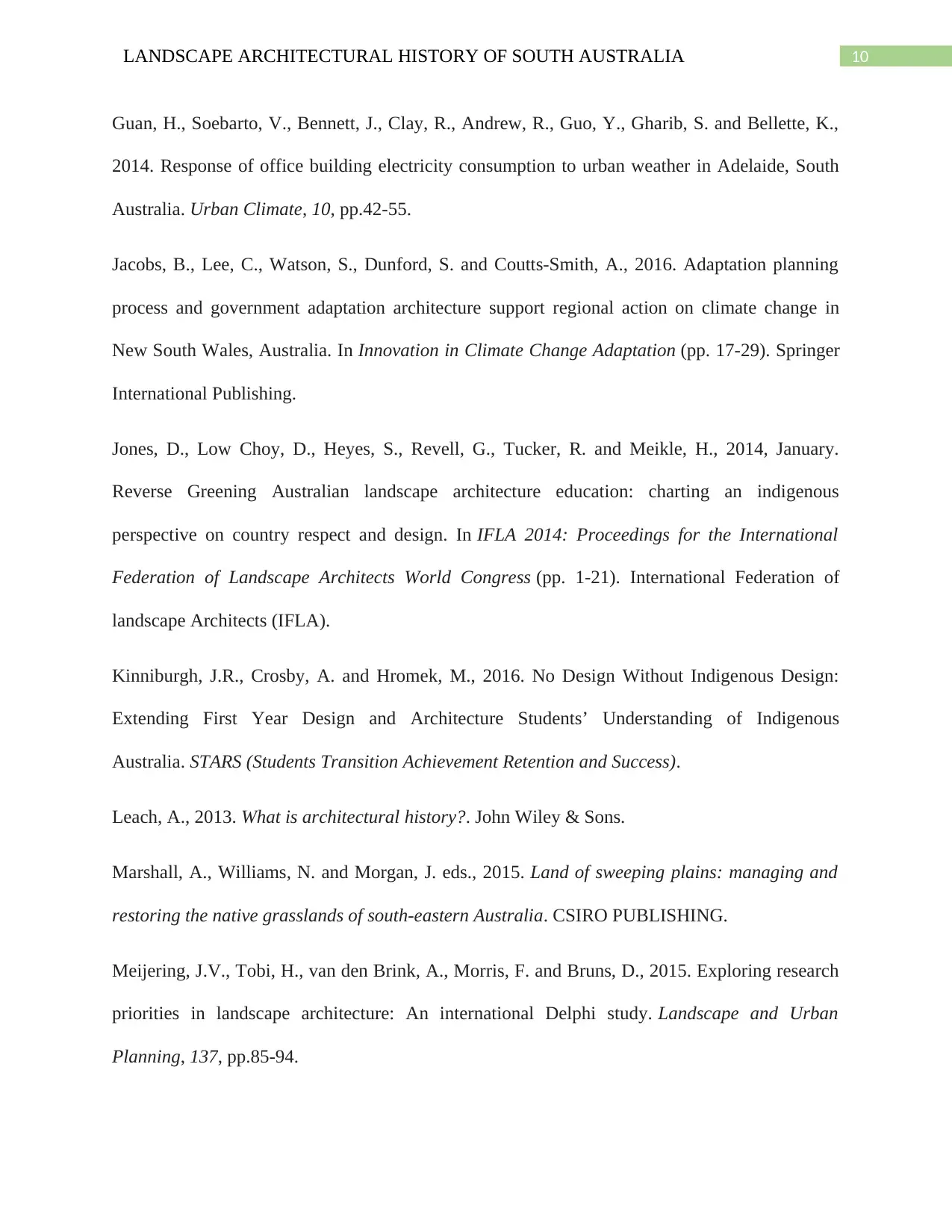
10LANDSCAPE ARCHITECTURAL HISTORY OF SOUTH AUSTRALIA
Guan, H., Soebarto, V., Bennett, J., Clay, R., Andrew, R., Guo, Y., Gharib, S. and Bellette, K.,
2014. Response of office building electricity consumption to urban weather in Adelaide, South
Australia. Urban Climate, 10, pp.42-55.
Jacobs, B., Lee, C., Watson, S., Dunford, S. and Coutts-Smith, A., 2016. Adaptation planning
process and government adaptation architecture support regional action on climate change in
New South Wales, Australia. In Innovation in Climate Change Adaptation (pp. 17-29). Springer
International Publishing.
Jones, D., Low Choy, D., Heyes, S., Revell, G., Tucker, R. and Meikle, H., 2014, January.
Reverse Greening Australian landscape architecture education: charting an indigenous
perspective on country respect and design. In IFLA 2014: Proceedings for the International
Federation of Landscape Architects World Congress (pp. 1-21). International Federation of
landscape Architects (IFLA).
Kinniburgh, J.R., Crosby, A. and Hromek, M., 2016. No Design Without Indigenous Design:
Extending First Year Design and Architecture Students’ Understanding of Indigenous
Australia. STARS (Students Transition Achievement Retention and Success).
Leach, A., 2013. What is architectural history?. John Wiley & Sons.
Marshall, A., Williams, N. and Morgan, J. eds., 2015. Land of sweeping plains: managing and
restoring the native grasslands of south-eastern Australia. CSIRO PUBLISHING.
Meijering, J.V., Tobi, H., van den Brink, A., Morris, F. and Bruns, D., 2015. Exploring research
priorities in landscape architecture: An international Delphi study. Landscape and Urban
Planning, 137, pp.85-94.
Guan, H., Soebarto, V., Bennett, J., Clay, R., Andrew, R., Guo, Y., Gharib, S. and Bellette, K.,
2014. Response of office building electricity consumption to urban weather in Adelaide, South
Australia. Urban Climate, 10, pp.42-55.
Jacobs, B., Lee, C., Watson, S., Dunford, S. and Coutts-Smith, A., 2016. Adaptation planning
process and government adaptation architecture support regional action on climate change in
New South Wales, Australia. In Innovation in Climate Change Adaptation (pp. 17-29). Springer
International Publishing.
Jones, D., Low Choy, D., Heyes, S., Revell, G., Tucker, R. and Meikle, H., 2014, January.
Reverse Greening Australian landscape architecture education: charting an indigenous
perspective on country respect and design. In IFLA 2014: Proceedings for the International
Federation of Landscape Architects World Congress (pp. 1-21). International Federation of
landscape Architects (IFLA).
Kinniburgh, J.R., Crosby, A. and Hromek, M., 2016. No Design Without Indigenous Design:
Extending First Year Design and Architecture Students’ Understanding of Indigenous
Australia. STARS (Students Transition Achievement Retention and Success).
Leach, A., 2013. What is architectural history?. John Wiley & Sons.
Marshall, A., Williams, N. and Morgan, J. eds., 2015. Land of sweeping plains: managing and
restoring the native grasslands of south-eastern Australia. CSIRO PUBLISHING.
Meijering, J.V., Tobi, H., van den Brink, A., Morris, F. and Bruns, D., 2015. Exploring research
priorities in landscape architecture: An international Delphi study. Landscape and Urban
Planning, 137, pp.85-94.
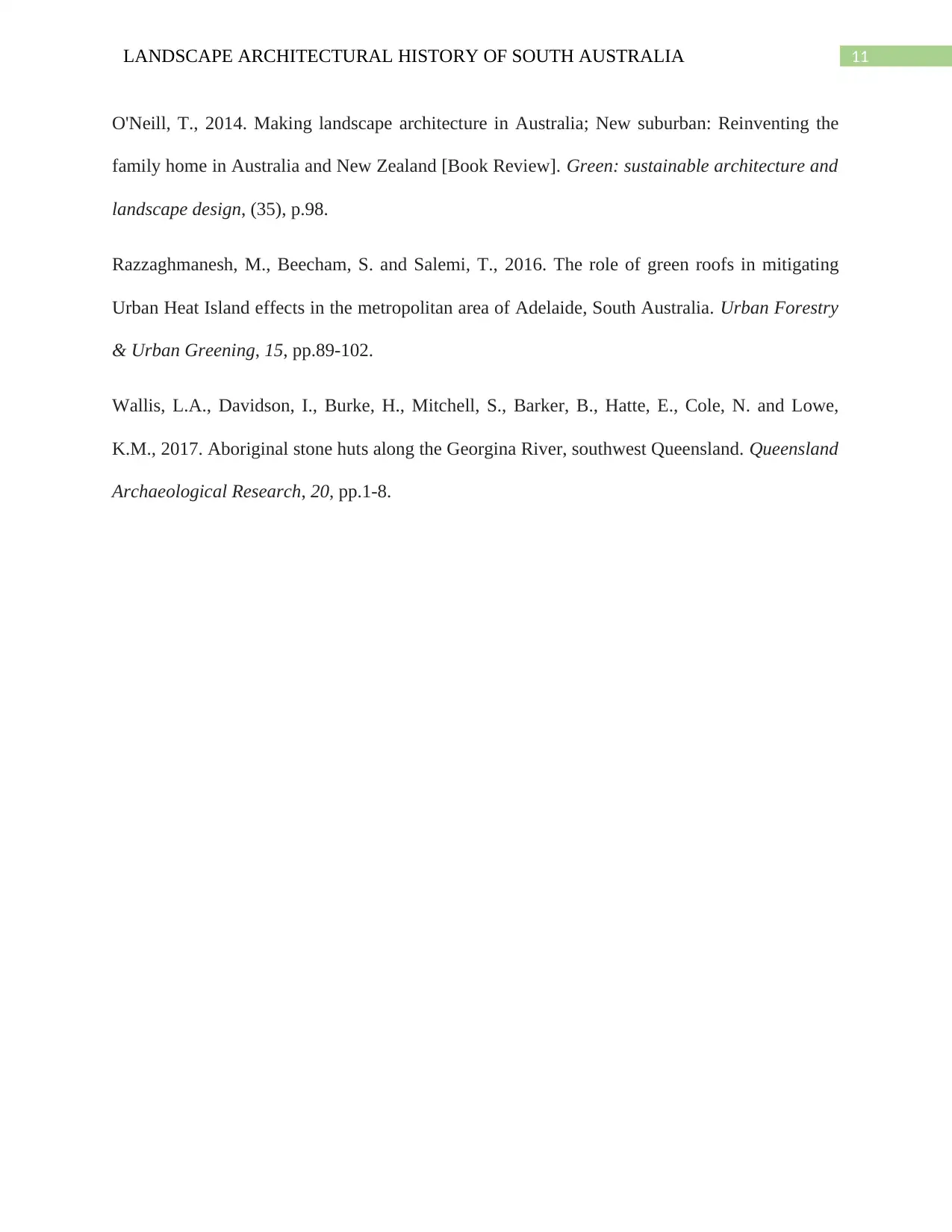
11LANDSCAPE ARCHITECTURAL HISTORY OF SOUTH AUSTRALIA
O'Neill, T., 2014. Making landscape architecture in Australia; New suburban: Reinventing the
family home in Australia and New Zealand [Book Review]. Green: sustainable architecture and
landscape design, (35), p.98.
Razzaghmanesh, M., Beecham, S. and Salemi, T., 2016. The role of green roofs in mitigating
Urban Heat Island effects in the metropolitan area of Adelaide, South Australia. Urban Forestry
& Urban Greening, 15, pp.89-102.
Wallis, L.A., Davidson, I., Burke, H., Mitchell, S., Barker, B., Hatte, E., Cole, N. and Lowe,
K.M., 2017. Aboriginal stone huts along the Georgina River, southwest Queensland. Queensland
Archaeological Research, 20, pp.1-8.
O'Neill, T., 2014. Making landscape architecture in Australia; New suburban: Reinventing the
family home in Australia and New Zealand [Book Review]. Green: sustainable architecture and
landscape design, (35), p.98.
Razzaghmanesh, M., Beecham, S. and Salemi, T., 2016. The role of green roofs in mitigating
Urban Heat Island effects in the metropolitan area of Adelaide, South Australia. Urban Forestry
& Urban Greening, 15, pp.89-102.
Wallis, L.A., Davidson, I., Burke, H., Mitchell, S., Barker, B., Hatte, E., Cole, N. and Lowe,
K.M., 2017. Aboriginal stone huts along the Georgina River, southwest Queensland. Queensland
Archaeological Research, 20, pp.1-8.
⊘ This is a preview!⊘
Do you want full access?
Subscribe today to unlock all pages.

Trusted by 1+ million students worldwide
1 out of 12
Related Documents
Your All-in-One AI-Powered Toolkit for Academic Success.
+13062052269
info@desklib.com
Available 24*7 on WhatsApp / Email
![[object Object]](/_next/static/media/star-bottom.7253800d.svg)
Unlock your academic potential
Copyright © 2020–2025 A2Z Services. All Rights Reserved. Developed and managed by ZUCOL.





